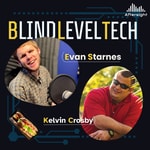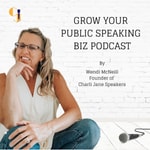Blind Level Tech – Details, episodes & analysis
Podcast details
Technical and general information from the podcast's RSS feed.

Blind Level Tech
Aftersight
Frequency: 1 episode/6d. Total Eps: 151

Recent rankings
Latest chart positions across Apple Podcasts and Spotify rankings.
Apple Podcasts
🇨🇦 Canada - techNews
03/08/2025#44🇬🇧 Great Britain - techNews
03/08/2025#45🇺🇸 USA - techNews
03/08/2025#66🇨🇦 Canada - techNews
02/08/2025#31🇬🇧 Great Britain - techNews
02/08/2025#31🇺🇸 USA - techNews
02/08/2025#78🇺🇸 USA - techNews
31/07/2025#94🇬🇧 Great Britain - techNews
28/07/2025#98🇺🇸 USA - techNews
28/07/2025#86🇬🇧 Great Britain - techNews
27/07/2025#79
Spotify
No recent rankings available
Shared links between episodes and podcasts
Links found in episode descriptions and other podcasts that share them.
See allRSS feed quality and score
Technical evaluation of the podcast's RSS feed quality and structure.
See allScore global : 49%
Publication history
Monthly episode publishing history over the past years.
The Latest and Greatest from Android
mercredi 9 octobre 2024 • Duration 32:06
In this episode of Blind Level Tech, hosts Evan Sarnes and Kelvin Crosby discuss the latest updates to TalkBack, the Android screen reader, and explore its features, including image descriptions, guided frame, and enhancements to the magnifier app. They also touch on the accessibility improvements for Braille users and live transcription features, ultimately debating the merits of Android versus iOS for accessibility.
Takeaways
• TalkBack has evolved significantly since its inception. • The ability to describe images in detail is a game changer. • Guided frame helps users align their faces for video calls. • The magnifier app now uses AI for text recognition. • Braille gestures have been updated for better usability. • Live transcription features have improved for deaf-blind users. • The choice between Android and iOS depends on user needs.
Chapters
00:00 Introduction to Blind Level Tech 01:57 Exploring TalkBack and Android Updates 06:28 Key Features of TalkBack 10:51 Image Descriptions and Guided Frame 15:39 Enhancements in the Magnifier App 19:24 Braille Gestures and Accessibility 22:14 Live Transcription Improvements 26:50 The Big Question: Android or iOS?
BLT Bite ReRun: setting up the Talkback Shortcut on android
mardi 8 octobre 2024 • Duration 04:52
BLT Bites: Be My AI Comes To Windows
mardi 27 août 2024 • Duration 09:24
The Be My Eyes app for Windows allows users to take pictures and have an AI model describe them. The app is available in the Microsoft Store and requires a Microsoft account. Users can sign in with their Be My Eyes account or create a new one. The app includes features such as describing the screen, taking pictures using the built-in camera, uploading existing photos, and copying images to the clipboard for description. The app also has customizable keyboard shortcuts and a settings tab. Overall, the Be My Eyes app for Windows provides a convenient way for visually impaired individuals to access visual information.
Takeaways
The Be My Eyes app for Windows allows visually impaired individuals to access visual information through an AI model.
The app includes features such as describing the screen, taking pictures, uploading existing photos, and copying images for description.
Users can customize keyboard shortcuts and access settings for the app.
The app requires a Microsoft account and is available in the Microsoft Store.
chapters 00:00 Introduction to Be My Eyes App
01:01 Installing and Signing In
02:23 Screen Description and Picture Taking
03:50 Customizing Keyboard Shortcuts and Settings
BLT Bite: PiccyBot
mercredi 21 août 2024 • Duration 09:28
PiccyBot: Not Just an Image Description Application
mercredi 21 août 2024 • Duration 39:00
In this episode, the hosts interview Martijn Van Der Spek, the developer of the app PiccyBot, an AI-based image description app. They discuss the different AI models used in the app, such as Gemini, GPT-3.5, RECA, GPT-4.0, and GROK2, and how each model has its own strengths and weaknesses. They also talk about the advantages of using open-source models like LAMA for privacy. The hosts explore the possibility of merging multiple models to create a supermodel and the potential risks of using AI for image description. They also mention the personality switch feature in PiccyBot that allows users to customize the description style. PiccyBot is an app that uses AI to provide descriptions of images and videos for blind and visually impaired users. It stands out from other similar apps because it offers multiple models and personalities, and it is currently the only app that provides video descriptions. The app is available on both iOS and Android platforms, and it offers a free version with limited features and ads, as well as a paid version with additional capabilities. The developer is hoping to secure grant funding to further improve and expand the app. PiccyBot has the potential to be integrated into other devices and applications, such as a smart cane.
Chapters
00:00 Introduction and Personal Updates
03:04 Tech Piece of the Week: I Fix It Kit and Zoom P4 Podcast Mixer
07:07 The Power of Different AI Models in Image Recognition
13:14 Exploring the Strengths and Niches of AI Models
16:43 Privacy and Control: The Benefits of Open-Source AI Models
18:31 Creating a Supermodel: Merging AI Models for Better Image Description
20:30 Customizing Image Descriptions with Pickybot's Personality Switch
21:01 Introduction to PiccyBot and its Description Features
22:31 Customization and Fun with PiccyBot's Personalities
23:20 The Importance of Video Descriptions
24:52 The Benefits of Upgrading to the Paid Version
25:19 PiccyBot's Pricing Model
26:12 Seeking Grant Funding for PiccyBot's Development
28:07 Cross-Platform Availability and Development Process
29:30 Future Plans for PiccyBot and User Feedback
31:57 Opportunity for Public Voting in Google Gemini AI Competition
32:32 Promoting PiccyBot and Support for the App
35:14 Sandwich of the Week: Subby Tuna, Croissant with Boa, and Buffalo Chicken Slider
37:44 Where to Find PiccyBot and Connect with the Developer
39:31 Final Thoughts and Encouragement
Thank you for listening to this episode of BLT if you have questions you know what to do. (720) 712-8856 or email at feedback@aftersight.org
Marty Sobo: Unmute Yourself
mercredi 14 août 2024 • Duration 44:17
In this conversation, the hosts and guest discuss various topics related to technology and personal experiences. They start by sharing their recent hiking experience and the inspiring story of a blind hiker. Then, they move on to discuss tech recommendations, including microphones and packing cubes. The conversation shifts to Marty's journey in the music industry and his work with Apple. They also touch on the topic of Apple's new M1 processors and the right to repair. Marty shares his experience adapting to vision loss and learning to use assistive technology like VoiceOver. The conversation covers topics such as multitasking with multiple audio sources, the creation of ACB Community, the growth of the Unmute podcast, and challenges faced by beginners in using technology. The main takeaways include the importance of simplifying technology for beginners, the value of patience in waiting for a better outcome, and the need for intuitive and user-friendly interfaces. The conversation is divided into two chapters: 'ACB Community and Unmute Podcast' and 'Challenges Faced by Beginners in Using Technology'.
Chapters
00:00 Inspiring Stories from a Recent Hiking Trip
03:31 Tech Recommendations: Microphones and Packing Cubes
09:03 Journey in the Music Industry and Work with Apple
12:55 Apple's M1 Processors and the Right to Repair
17:21 Adapting to Vision Loss and Learning Assistive Technology
23:12 ACB Community and Unmute Podcast
31:09 Challenges Faced by Beginners in Using Technology
Thank you for listening to this episode of Blind Level Tech. As always if you have questions, reach out to us at Feedback@aftersight.org or give us a call at (720) 712-8856. Have a great week.
BLT BITES: Useful Windows Keystrokes
mardi 13 août 2024 • Duration 03:18
If you would like a tip or topic covered in our weekly BLT BITE Segment, let us know by emailing us at feedback@aftersight.org Or call us at (720) 712-8856
Accessible Microphones and What You Should and Shouldn't Get
mercredi 7 août 2024 • Duration 41:00
In this episode of Blind Level Tech, the hosts discuss microphones for podcasting and voiceover recording. They start by talking about the mics they are currently using, including the Audio-Technica AT2020 condenser microphone and the CAD GXL2200. They explain the difference between condenser and dynamic microphones and the best use cases for each. They also discuss built-in microphones in devices like laptops and phones, noting that while they can be convenient, they often lack in audio quality. The hosts then explore different types of microphones in various price ranges, including USB mics, XLR mics, and headset mics. They provide recommendations for affordable microphones and caution against using headset mics for professional audio work. They also mention the Blue Yeti microphone as a versatile option with multiple polar patterns. They cover popular options like the Blue Yeti and the Shure MV7, as well as higher-end models like the AKG C414. They also mention the importance of considering the sound profile, polar patterns, and durability when choosing a microphone. The conversation concludes with a discussion about their favorite sandwiches.
Takeaways
Condenser microphones are good for picking up audio from the room, while dynamic microphones are better for dialogue and close-up recording.
Built-in microphones in devices like laptops and phones often lack in audio quality and are not recommended for professional audio work.
Affordable microphones in the $20 to $60 price range can significantly upgrade audio quality, with options like Logitech, Zeal Sound, and CAD microphones.
Headset mics are convenient but may pick up vibrations from the head and produce unpleasant audio quality. They are not recommended for voiceovers.
The Blue Yeti microphone is a versatile option with multiple polar patterns and a built-in sound card for monitoring and adjusting audio levels.
Proper microphone placement and technique are important for achieving good audio quality. There are many microphones available for podcasting and voiceover work in the $100 to $250 price range.
The Shure MV7 is a popular choice among podcasters and offers both XLR and USB options.
Other options in this price range include the Blue Yeti, Audio-Technica, and Sennheiser microphones.
Higher-end microphones like the Lewitt Ray and AKG C414 offer advanced features and exceptional sound quality.
Consider factors like sound profile, polar patterns, and durability when choosing a microphone.
Rode microphones are also worth considering for their range of podcasting options.
Don't forget to toast your burger buns for extra deliciousness!
Chapters
00:00 Choosing the Right Microphone
10:14 Understanding Microphone Types
13:00 Built-in Microphones in Devices
18:32 Affordable Microphones
20:09 Headset Mics for Voiceovers
23:10 Middle of the Road Mics
25:07 Microphone Placement and Technique
25:37 Introduction to Microphones for Podcasting
26:10 The Shure MV7: A Popular Choice
27:07 Exploring Other Microphone Options
28:30 Considerations for Choosing a Microphone
31:07 The Shure MV7 Plus and Other Options
32:24 Advanced Features: Lewitt Ray and AKG C414
35:38 Rode Microphones for Podcasting
38:21 Sandwich of the Week: Pulled Pork Sliders and Burgers
39:05 Sandwich of the Week: Sonic Double Cheeseburger
39:45 Sandwich of the Week: Elk Burger
40:26 Announcement: Shine Music Fest
41:38 Conclusion and Farewell
Thank you for listening to this episode of Blind Level Tech. If you have any questions for Evan or Kelvin please visit us at feedback@aftersight.org or give us a call at 720-712-8856..
BLT Bite: a demo of the Adobe Speach Enhancer
mardi 6 août 2024 • Duration 05:31
Technology and Schooling
mercredi 31 juillet 2024 • Duration 44:33
In this conversation, Evan and Kelvin discuss technology and accommodations for visually impaired students in K-12 and college. They highlight the importance of advocating for accommodations and familiarizing oneself with disability support services. They also discuss the challenges of obtaining textbooks and recommend getting book lists early. Overall, they emphasize the need for preparation and self-advocacy in order to succeed in school. The conversation explores the accessibility of textbooks and navigating in-person and online classes for students with visual impairments. It emphasizes the importance of having legal copies of accessible textbooks and the need to advocate for accessibility in online platforms. The hosts share their experiences with finding classes and accommodations, including using guide dogs and working with disability services. They discuss the challenges of taking tests and the importance of advocating for accessible testing options. The conversation concludes with a discussion on the future of accessibility in education.
Takeaways
Advocacy is crucial for visually impaired students to obtain necessary accommodations in school.
Knowing the disability support services at your school and how they work is important for accessing accommodations.
Transitioning from high school to college can be challenging, and it is important to be prepared and familiar with the support services available.
Obtaining accessible textbooks can be a challenge, and it is recommended to get book lists early and communicate with professors and disability services.
Preparation and self-advocacy are key to success in school for visually impaired students. Having legal copies of accessible textbooks is important to comply with copyright law.
Building a good relationship with disability services can lead to better accommodations.
Training guide dogs to navigate campus can help with finding classes.
Advocacy is necessary to ensure accessibility in online platforms and testing options.
The future of accessibility in education should involve easily accessible textbooks and online platforms.
Chapters
00:00 Introduction and Personal Updates
06:39 Navigating Technology and Accommodations for Visually Impaired Students
11:45 The Importance of Advocacy in Obtaining Accommodations
15:12 Transitioning from High School to College: Challenges and Preparation
19:40 Challenges of Obtaining Accessible Textbooks
21:39 Preparation and Self-Advocacy for Success in School
25:38 Finding Classes and Accommodations
27:34 Navigating Campus with Guide Dogs
30:17 Advocating for Accessibility in Online Platforms
42:10 The Future of Accessibility in Education
Thank you for listening to this episode of BLT. If you have nay questions, please let us know by giving us a phone call at (720) 712-8856, or you can email us at feedback@aftersight.org. Have a great week.



